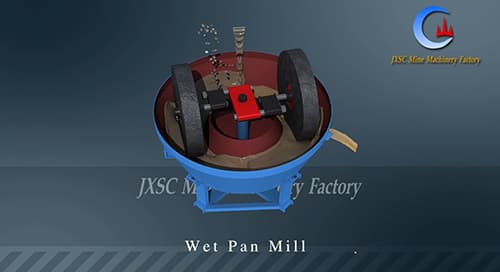Wet Pan Mill
It is grinding Rock such as rock gold ore /rock tin ore/ rock tungsten ore/ rock chrome ore/rock coltan ore,ect.
Capacity: 0.5-3 t/h
Applicable materials: ferrous metals, non-ferrous metals and non-metals, as well as precious metals such as gold, silver and tin ore.
Description
The Wet Pan Mill is also called wet grinding machine. According to different structures, it can be divided into two-roller mill and three-roller mill, and the most commonly used one is double-roller mill. It is praised by users because of its low investment, good particle size after grinding (can be as fine as -1mm), low energy consumption, high efficiency, and convenient installation and maintenance. It is an excellent equipment to replace grinding balls. The wet mill is especially suitable for grinding precious metals, gold and silver, and is an ideal equipment for small and medium-sized grinding.
The specifications of wet pan mill are denoted by the diameter of the grinding roller. Wet pan mill of Ф1600, Ф1500, Ф1400, Ф1350, and Ф1300 types are available for gold, iron, molybdenum, lead, zinc, antimony, and other ores. Wet pan mill of Ф1200, Ф1100, Ф1000, Ф900, and Ф850 types are available for gold mining.
Advantages
- Low investment, low production cost. Excellent grinding effect.
- The fineness of the final product can be adjusted by adjusting the speed of the grinding roller and the quantity of grinding media.
- Low energy consumption, safe operation, and easy operation.
Principle
Principle
During operation, the grinding wheel revolves around the vertical axis and can also rotate around the center axis of the grinding wheel. During the rotation process, the stone is subjected to the squeezing, kneading, and grinding of the grinding wheel, resulting in fragmentation. The grinding wheel also functions to mix the slurry during the grinding process. The finely ground particles are carried to the upper layer of the liquid surface in the agitated slurry and overflow from the overflow outlet of the water basin, while the coarse particles settle at the bottom of the grinding disc and continue to be ground until the required fineness is achieved. The discharge outlet of the water basin is equipped with a sieve to further control the particle size of the discharged material, ensuring the quality of the final product.

Specification
| Model | Feeding size(mm) | Output size(mm) | Capacity(t/h) | Rotation speed (r/min) | Power(kw) | Weight(t) |
| 1100 | <20mm | <1mm | 0.5T/H | 11-19RPM | 5.5KW | 4.8T |
| 1200 | <20mm | <1mm | 0.5-1T/H | 11-19RPM | 7.5KW | 5.2T |
| 1400 | <20mm | <1mm | 1-1.5 T/H | 18-21RPM | 15KW | 9.5T |
| 1500 | <30mm | <1mm | 1.5-2T/H | 18-22 RPM | 22KW | 11T |
| 1600 | <30mm | <1mm | 2-3 T/H | 18-20 RPM | 30/37KW | 12.5T |
